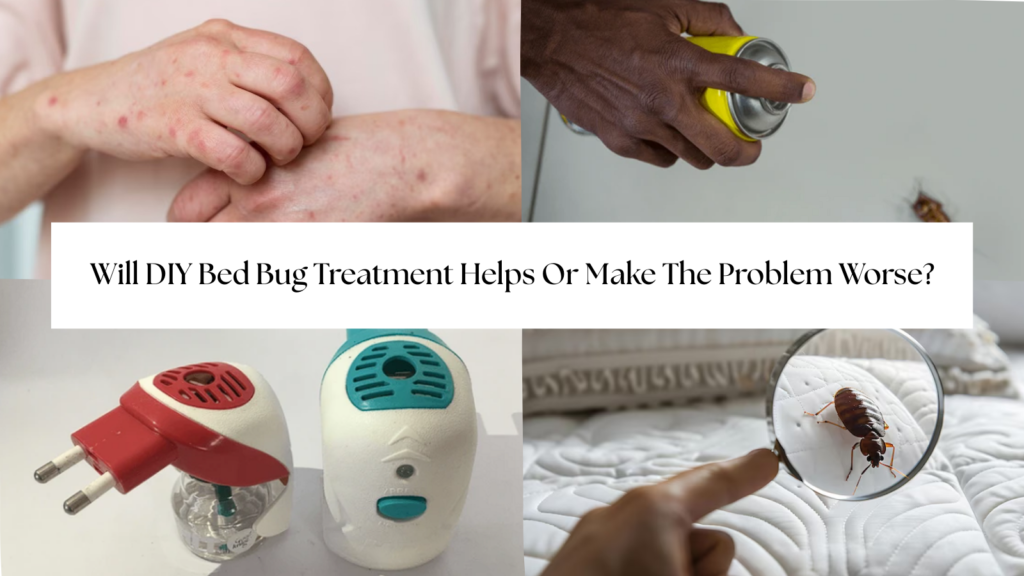Will DIY Bed Bug Treatment Helps Or Make The Problem Worse?

The unwanted visitors that nobody wants are bed bugs. Beds, couches, and even the cracks in your walls are frequently invaded by these tiny, blood-sucking bugs, leaving behind itching bites and a great deal of worry. Before contacting a professional, many people attempt do-it-yourself (DIY) solutions when dealing with an infestation. The true concern, though, is whether do-it-yourself bed bug remedies are effective or if they can exacerbate the issue.
Let’s examine common do-it-yourself solutions in detail, assess their benefits and drawbacks, and assist you in determining whether to consult professionals.
Acceptance the Issue of Bed Bugs
Knowing your enemy is crucial before you take that bottle of vinegar or essential oil spray.
Bed bugs are reddish-brown, tiny (4–5 mm) insects that usually feed on human blood at night. They are very good at hiding under baseboards, beds, luggage, electrical outlets, and furniture seams. Their ability to go months without eating and their resistance to several prescription drugs make them especially challenging.
- Tiny red welts that itch (typically in a line or cluster)
- Bed bug droppings are tiny black dots on bedding.
- Real bugs or molten skins concealed in mattress seams
DIY fixes frequently seem like the quickest and least expensive option when people first notice bed insect symptoms. The following are a few of the more typical ones:
- Essential Oils
Because of their strong smells, peppermint, the one from e lavender, and tea tree oil are commonly used. According to some, these oils either kill or repel bed bugs.
🔸 Reality check: Essential oils don’t kill bugs or get to their concealed nests, but they may temporarily repel them.
2. Baking Diatomaceous Earth or Soda
By dehydrating and destroying the bugs’ exoskeletons, these powders are sprayed all over the bed area.
🔸 A sobering reminder that diatomaceous earth may only respond when in direct touch and may act slowly. Baking soda doesn’t really work.
3. Heating Procedures
To get rid of bugs, people utilize blow dryers, steamers, and even simply placing mattresses in the sun.
Reality check: Although home appliances sometimes don’t provide continuous or deep enough heat, bed bugs die around 113°F (45°C) or above.
4. Mattress encasements and vacuuming:
After vacuuming the mattress and its surroundings, put it in a zipped bag to keep any pests out.
🔸 A disheartening reminder that while vacuuming can get rid of some pests, they can nevertheless live as eggs or in crevices. Although they are not stand-alone solutions, enclosures are helpful.
5. DIY Sprays (Rubbing Alcohol, Vinegar, etc.)
It is believed that bugs can be killed by directly spraying them with vinegar or alcohol.
🔸 Reality check: Alcohol is toxic and rapidly evaporates, but it may kill on touch. Vinegar doesn’t do much.
The Advantages of Homemade Bed Bug Remedies
Not all do-it-yourself approaches are harmful, particularly when used as short-term fixes while awaiting expert assistance or in mild circumstances.
✅ Cheap: You probably already have most of the components.
✅ Instant Reaction: There is no need for a schedule; you can take action immediately.
✅ Non-Toxic Options: Natural treatments are safe for kids and pets.
✅ Beneficial in Early Infestation: If detected early, DIY may help lower the population.
The Drawbacks of Homemade Bed Bug Treatments
Unfortunately, DIY therapies have a drawback, particularly if done incorrectly.
❌ Incomplete Eradication: Bed bugs lurk in areas that are inaccessible to most do-it-yourself projects. Time-consuming: It might be draining to apply repeatedly over several weeks.
❌ False Sense of Security: After a period of time, bugs may reappear stronger.
When Do-It-Yourself Becomes Risky
Unbelievably, attempting to combat bed bugs on your own can backfire.
Using chemicals excessively, such as rubbing alcohol indoors, has resulted in fire hazards. Using pesticides together without understanding how they interact can create toxic vapors. Infestations can intensify and spread if expert assistance is delayed.
When to Make a Professional Call
Even if doing it yourself can seem like a good idea at first, it’s not always sufficient, particularly for moderate to severe infestations.
You notice live bed bugs throughout the day, which is a sign that you need a pest control specialist.
The bites are spreading or getting worse.
After two to three weeks, do-it-yourself solutions have failed.
You see bed bugs in several of the rooms.
What Experts Provide: Chemical applications or focused heat treatments
proficiency in locating hiding places
Use of pesticides in a safe and controlled manner
Follow-up appointments to guarantee complete eradication
Although professional services are more expensive up front, they are much more successful and frequently less expensive in the long run when do-it-yourself projects fail.
Conclusion
Do Homemade Remedies Help or Make Things Worse?
Particularly in the early phases, do-it-yourself bed bug treatments can offer momentary respite. However, they are not always effective, and relying too much on them might exacerbate infestations and make them more difficult to get rid of in the future.
Save yourself the worry by contacting a certified pest control business if you’re dealing with a severe or persistent infestation.
Half-measures can result in full-blown nightmares when it comes to bed bugs.